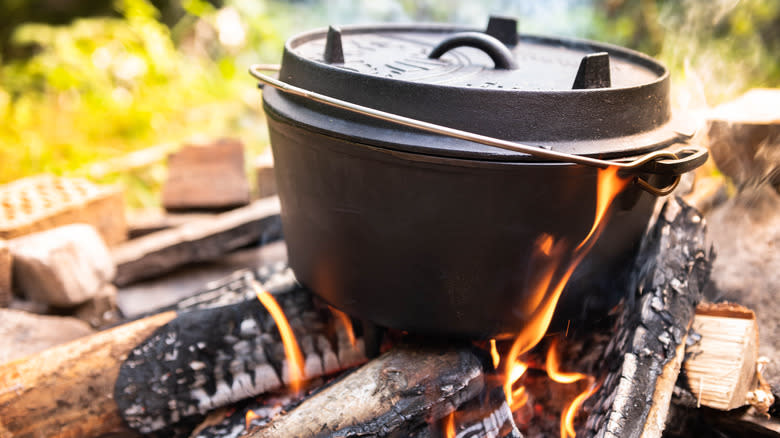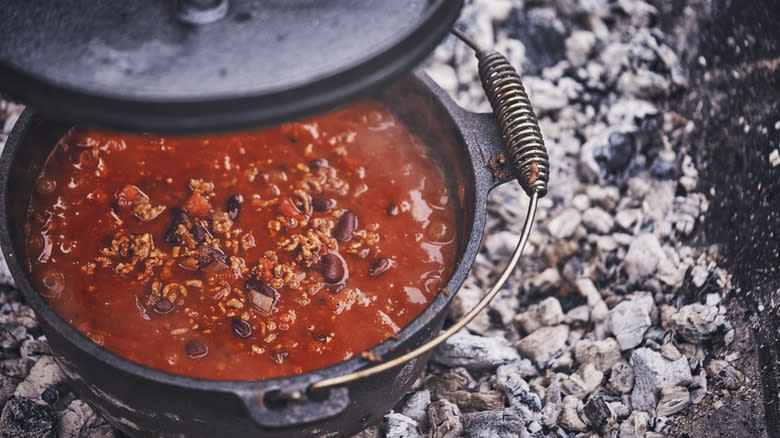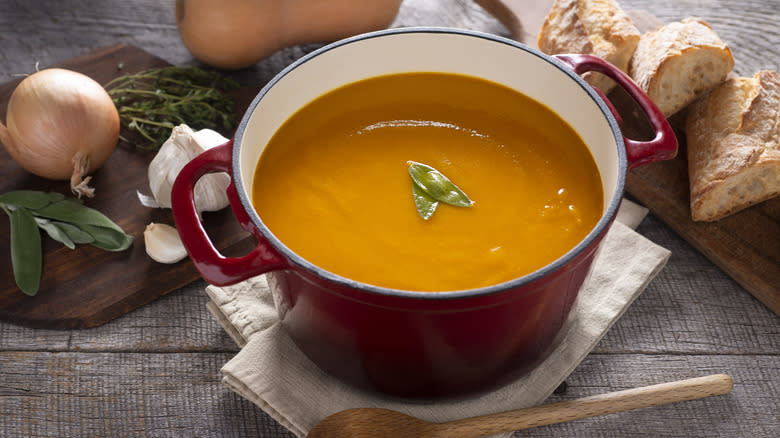The Origin Of The Dutch Oven And How It Got Its Name

If you're not sure what a Dutch oven is, you've probably seen one before. They're heavy, versatile cast-iron pots that are perfectly designed to cook anything from briskets to stews to bread. But the name can seem like a bit of a mystery, even if you ignore the fact that the Dutch oven is not actually an oven. You also might be wondering if they were actually invented in the Netherlands.
The short answer is "kind of, but not exactly." In fact, the Dutch oven as we know it was developed by a British industrialist named Abraham Darby in the early 1700s. He got the inspiration while on a trip to Holland, where he observed local Dutch artisans using sand-casting (a form of metal casting involving sand molds) to create cookware. Darby returned home and eventually developed his own cast-iron technique for creating cheap, sturdy pots using the Dutch methods he observed.
It's thought that he might've named his creation the "Dutch oven" because of this although some historians disagree and believe that specific name came from Dutch merchants who'd sell the pots. In the Netherlands, these kinds of pots are called braadpans anyway.
Read more: 12 Vegetables And Fruits That Used To Look Very Different
A Long (Mostly) Dutch History

Before Darby arrived in Holland, the Dutch were quite famous for their high-quality, expensive pots including their shallow, durable braadpans. The era was known as the "Dutch Golden Age" partly because of their successful advances in fields like metalworking (alongside art, sciences, and plenty more). Dutch artisans were casting brass and copper pots in sand molds long before Darby arrived. At the time, England was using inferior clay molds. Thus, part of Darby's success involved learning to cast iron in sand to make his Dutch ovens.
Some like to make a distinction between Dutch ovens and French ovens, which are the same shape of pot coated in enamel. However, a dish meant for one pot can easily be made using either instrument. This distinction only exists in the first place because after Darby's ovens became popular, other companies began selling their own versions of them. Eventually, a French company became widely popular for their enameled cooking pots. In France, these pots are known as cocottes.
What Goes In A Dutch Oven

The amount of foods you can cook up in a Dutch oven are too long to fit in one list, which is part of why they've been popular for so long. Historically, American colonists frequently used them for cooking stews and roasts. The pots were highly useful tools for mountaineers and travelers who needed a durable pot to cook over campfires out in the wilderness as well. Famously, the explorers Meriweather Lewis and William Clark were said to carry a Dutch oven among their supplies during expeditions.
Nowadays, it's common to see people bake with Dutch ovens. They're great choices for baking beans, pies, casseroles, and loaves of bread. Dutch ovens are also perfect for cooking briskets and other one-pot meat dishes such as lamb shoulders or beef stews. You can even make simple things like pasta in Dutch ovens. If you have a larger-sized Dutch oven, you can cook entire chickens. Just be aware that these pots can be heavy. Even if they aren't the easiest thing to handle, their versatility and bulkiness are part of what makes them so effective.
Read the original article on Daily Meal.

